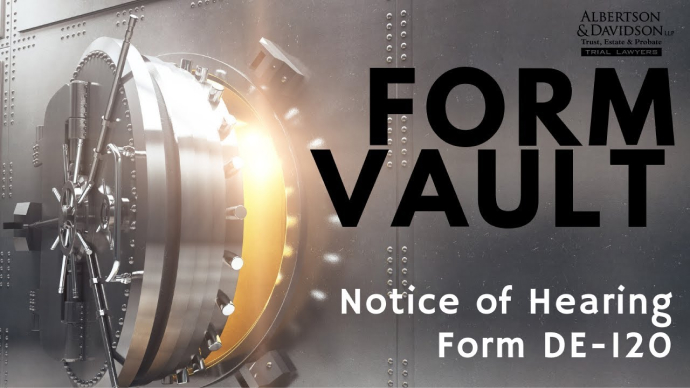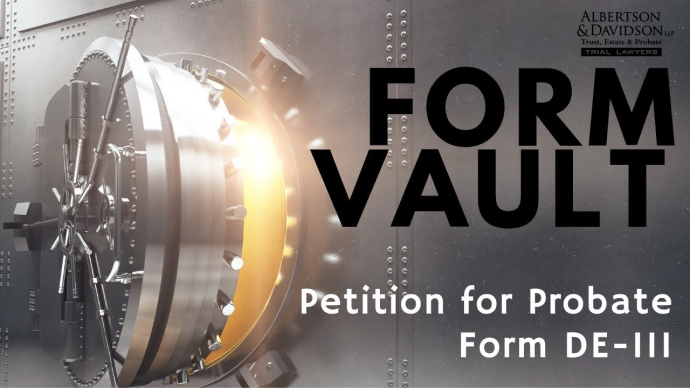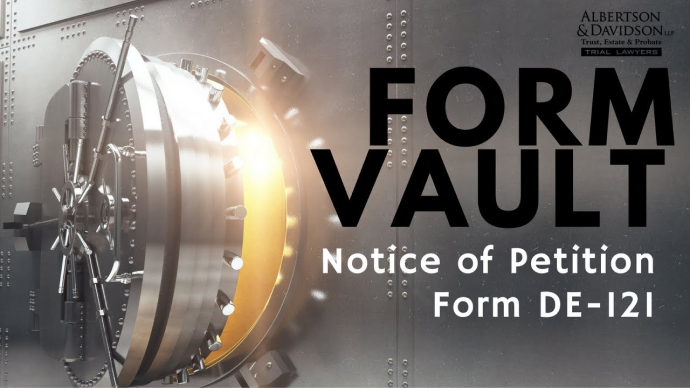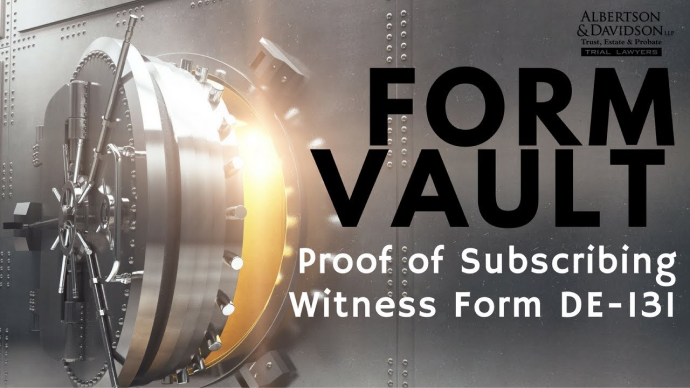Video Transcript
The following is an unedited, verbatim transcript of our video. It is not intended to be a stand-alone article.
Hi, this is Keith Davidson from Albertson and Davidson. In this video, I’m going to walk you through how to prepare a notice of hearing. So, if you have a case in probate court – a trust case, a will case, almost every single case is going to require a notice of hearing once the court sets a hearing date. So let’s go through what a notice of hearing looks like a how you can fill one in. So the first I do is I actually just go to Google and I just type in judicial council forms, and the California Judicial Council actually has a whole bunch of forms that you can use in a different types of lawsuits. So, we’re going to select the category, we’re going to go down here to probate, and Decedents Estates, and this is where you’re going to find all the forms for not just Estates like probate but also for Trusts matters. And we’ll go ahead and see the forms. I already know that we want form DE-120, but if I didn’t know that, you could search for for by name or by number. But I know what form we want, it’s DE-120. And here it is in large format. And what this is, this is a form that you use to document that you actually fill out and then mail out to all the related parties in you lawsuit in order to notify them of when a court hearing has been set by a court. And the person who files the document with the court, is the person who is responsible for notifying everybody else about the court hearing that was assigned by the court.
Page 1
So, we start of at the top and we just going to type in our name, if you were doing this and you were representing yourself, you would just put your own name in here, but I’m going to use mine, and then I’m going to put in my law firm information, so if you’re a lawyer you’re going to do that, if you’re not you’re just going to put in your own address. And then I’m going to us the address that I’m at a lot of the time, Salk Avenue in Carlsbad. We have five different offices in California but I spend a lot of my time in San Diego County. And then you want to make sure you include your telephone number. You want the court and the other parties to be able to get a hold of you if they need to do so. Fax number if you have one, you can put in a fax, that’s optional, email is also optional but you should put one in because there’s times when the court might want to get hold of you and they will use email from time to time. And then you’re going to put here who you’re the attorney for. Now, if you’re not an attorney and you’re just appearing on your behalf, you can put Pro Per, that just means you’re representing yourself. The other thing you can do is just put in your own name. So, my name is Keith Davidson and I’m an attorney for Keith Davidson. Everybody will understand what that means. But I’m an attorney so I’m going to put in the name of my client, Bob Smith. And then you’re going to put in the county. So, let’s put in Los Angeles County, it;s the largest county in California, we have a lot of cases there although we are in a lot of different county. So whatever county you’re in, San Diego, Santa Clara, San MAteo, Orange County, Just type it in there. And then you have to put in the street address. And the first one is the address of the court where it it physically located, or, not or but and, the mailing address you have to pu in the court’s mailing address. Now in this case, they’re the same, but sometimes, they’re not. So if they’re not, you have to put in the proper addresses. Then here, you put the city and the zipcode. I don’t remember the zip code for Los Angeles but you can look it up and you put it right there. And the you put the branch name, so this is the Central Courthouse. If you don’t know the branch name of the court you’re dealing with, you can look it up on the website and if you can’t find one, you can just leave that blank.
Now down here, you’re going to check a box, and it’s going to depend on whether you’re doing an estate like a probate estate or you’re going to do anything else. So a trust matter, a conservatorship matter, guardianship matter, you’re going to check this box cause that’s all called In The Matter Of. And then you’ll type in what’s the matter is. So let’s say we’re doing a trust action, we’ll say The Bob Smith Trust, that’s the matter. If this was a conservatorship action, we’d say in the matter of and you type in The Conservatorship of and then whoever the name of the person is. So you can use this very widely for just about any other type of case that’s not a probate. And down here you’re going to click the box as to whether it’s a Decedent, meaning a probate estate, a Trust, or everything else. So if it’s not a probate estate or a trust, just click other. In this case, we’re doing a trust actions so we’re going to click trust.
Next, you’re going to put in the case number so the court knows where to file this once they receive it, and I just made up that number, but whatever your case number is, just put it in there.
Notice
And now this is the part where we really get started an ernest. So number 1, NOTICE is given that, and this is the party who filed the document that requires a hearing. So in our case, Bob Smith is the one giving notice. And representative capacity, if he were a trustee, I would type it in there, if he’s not, he’s just a regular Joe and he’s appearing on his behalf, then leave it blank. And then you’ll have to type in what you filed. SO maybe we did a Petition for Instruction; or a Petition for Trust Contest, whatever it is we did, just type it in there. In that way, people will understand what it is you’re giving them notice about.
Details About Hearing
And then on number 3, this is where we are going to give the details about the hearing. The court will give you the hearing date, and you’re going to type it in here, so November 1, 2018. Let’s say it’s 8:30 AM. Department, make sure you put the department. If there’s a room number you’ll put that, if it’s not a room number, most courts don’t have room number you just leave that blank. And then you’ll have to tell the parties where the address of the court is, where the hearing is going to be held. Most of the time, you’re just going to check “shown above”, which means this address up here, that’s where the hearing is going to be held. If the hearing is going to be held somewhere else other than the addresses up here, then you’ll check this box and you’ll specify the address, just type it in. Most of the time, you’re just going to click “shown above”. So that takes care the first page of our notice of hearing. So we’re in a good shape so far.
Page 2
So now we’re going to go down to the second page, you’ll see that the form automatically fills in the name of the matter and the case number so we’re good there. You’re going to skip this Clerk’s Certificate of Posting cause you’re not ever going to do that, instead you’re going to go to Proof of Service by Mail. You’re going to have to mail this out. And this is the whole purpose of this form is to prove that you mailed it out cause you’re going to sign this under penalty of perjury, which means that if you say something in here that isn’t true or if you don’t do something that’s stated in here, then there could be criminal consequences for having perjured yourself. So we’re going to make sure we fill this out right.
Proof of Service By Mail
So number 2, My residence or business address is, this is the place where you’re conducting the lawsuit out of. If you’re just doing it on your own, you can just put in your home address or you can put your work address, that’s fine, it doesn’t matter it either one will work. People just want to know where they can get hold of you. So I’m going to put my business address. And then we have two options, you can either deposit the sealed envelope with the United States postal service, meaning you’re the one who actually puts it into the postbox, or, you can place it into your mailing system at an office, so some big companies or big law firms have mailing departments, and so even though if I’m the one filling out this form, I may not be the one going out to the post office and putting the mail into the postbox, in which case I’m going to click b, which is I’m placing it to the mail system that our office has. I’m familiar with that system and I know that that system typically requires that anything I put in into that system is going to be mailed within that ordinary course of business, the same day, in a sealed envelope with post postage fully prepaid. So you have to know that that what’s your system does if you’re going to check this box. Otherwise, just check A if you’re the one taking it down, putting it in the mailbox, and you’ll be fine.
Put the date it’s mailed, everyone wants to know what day it was mailed so we’ll put October 1, 2018. And we’re going to say where it was mailed, so where exactly did you put this into the mail system, so that’s right here.
Number 5 is kind of interesting. So number 5 says that, not only did you mail this notice of hearing that we’re preparing now, but you also sent with it all of the documents referred to in this notice, and by that, they mean all the documents up here under number 1. And so it’s a very good practice, in our opinion, to do that. So when you serve a notice of hearing, also send copies of everything listed up here in number 1, in that way, you won’t have any other problems. Nobody can say, “We’ll, I didn’t get the documents” or something like that because you have proof that I put the notice of hearing in a sealed envelope along with all of these other documents and so I know that they received them or they should have received them. And then you’re going to put in the date that you actually sign this form and it doesn’t have to be the same date that you mailed it, some people say that it really should be the next day cause that way it’s already mailed, but usually you’re going to see that it’s the same day. And then you’re going to type in your name here, and when you print it out, you’re going to sign it over here. And again you’re signing this under penalty of perjury, so it you’re saying that you deposited it into the mail on October 1 in Carlsbad, California, that’s got to be right, so make sure you do that. And then you’re going to put the name and address of every person who received this mailing. If you have 4 or fewer people, you can put their names and addresses right here on the form, if you have more than that, you can use an attachment. Typically, what we do is we’ll check the attachment box and up here, we’re actually type See Attachment, just so everybody knows that there’s an attachment and nobody thinks that we filed a notice of hearing that’s blank. And even if I have 4 or fewer people on my notice attachment, I still will use an attachment because that way, I can keep the name and addresses of the parties and the lawyers on a seperate piece of paper, separate word document, and I can use that on all my filing. So sometimes, I have to attach a proof of service to something other than a notice of hearing, and I’ve got that notice list already, set-up, ready to go. And so here. Rather than typing everything in, all of times we’ll just use an attachment. So that means I have to actually attach that separate piece of paper to the notice of hearing, and I have to mail it out.
Mailing The Form
Now, once you’re done, you sign this, you mail out everything to everybody. You also have to file this form with the court, and that’s why at the top here, it looks like something you would file in court. So, after mailing it, you have to take it to the court, the court will stamp it over here in this clear area, and it will go into the court file, and then when you show up to your hearing, the judge is going to look for this, because they want to make sure that everybody receives the proper notice before the hearing can commence, cause the hearing can’t take place without notice. And if the judge looks in the file and doesn’t see this notice of hearing in the file, and your hearing going to get continued because that judge is going to say I can’t hear this matter today because you didn’t get proper notice and file proof of giving proper notice with the court. So it’s not good enough to actually fill out this form and do all of this stuff, you have to file this notice of hearing with the court too.
And then down here, you can save the form, you can print the form. And then, once you have it saved, you can use it over and over again. This is a form you’re going to use a lot in your case, because anytime there’s a hearing set, you have to mail one of this out. And anytime a hearing is continued, it’s very good practice to mail it out as well. In court, you might hear the attorney say, we waive notice, which means the next hearing can be set and you’re not required to send out this form, this notice of hearing. But it’s still a good idea to do it anyway, there’s no downside to giving people of notice of a hearing, there’s only upside, which is only “hey, I was just careful, I was being conservative, and I made sure that everybody knew about this hearing”.
So that’s how you prepare and file a notice of hearing in your probate court action.




